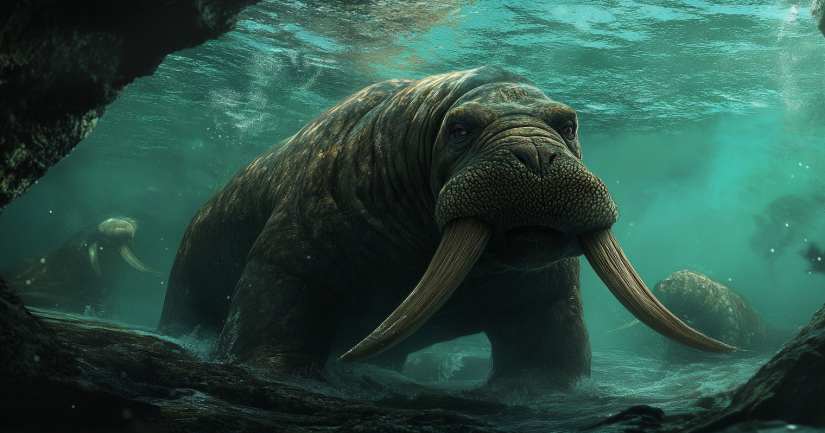
Walrus Trivia, Test Your Knowledge of These Arctic Giants! Lumbering across the ice and diving into frigid Arctic waters, walruses are some of the most distinctive marine mammals in the world. With their long tusks, thick blubber, and powerful whiskers, these massive creatures have adapted to one of the harshest environments on Earth. Despite their slow-moving appearance, walruses are expert divers and skilled hunters, using their sensitive whiskers to find food on the seafloor. But how much do you really know about these Arctic giants? Take our Walrus Trivia Quiz and find out!
Walruses (Odobenus rosmarus) are the only living species in their family, making them truly one-of-a-kind. They inhabit the cold waters of the Arctic, where they use ice floes as resting platforms and forage for clams, mussels, and other invertebrates.
Walruses are incredible and resilient, but the ocean is filled with diversity! Dive into the depths with our Tuna Trivia for more incredible fish, or discover the sea’s largest mammals in our Whale Quiz.
Mind-Blowing Walrus Facts That Might Surprise You
Their Tusks Are Actually Overgrown Teeth – A walrus’s famous tusks are actually elongated canine teeth, which can grow over 3 feet (1 meter) long! Both males and females have tusks, which they use for defense, dominance battles, and pulling themselves onto ice.
They Can Weigh Over a Ton – Adult walruses can weigh between 1,800 and 3,700 pounds (800–1,700 kg), making them one of the largest pinnipeds (a group that includes seals and sea lions).
They Have a Built-In “Life Jacket” – Walruses have a thick layer of blubber (up to 6 inches thick!), which helps them stay warm in freezing Arctic waters.
Their Whiskers Help Them Find Food – Walruses use their incredibly sensitive whiskers (vibrissae) to detect clams and other small prey buried under the seafloor.
They Can Hold Their Breath for Over 30 Minutes – When searching for food, walruses can dive up to 300 feet (90 meters) deep and stay underwater for extended periods.
Walrus Herds Can Be Massive – They are highly social animals, often gathering in herds of hundreds or even thousands on Arctic ice and coastal shores.
They “Sing” Underwater – Male walruses make clicks, whistles, and bell-like sounds during mating season to attract females. Some of these sounds are loud enough to be heard from miles away!
They Can Slow Their Heart Rate to Survive Cold Waters – Walruses can reduce their heart rate to conserve oxygen and withstand icy Arctic temperatures while diving.
Climate Change Is a Major Threat to Walruses – As Arctic ice melts due to global warming, walruses lose their natural resting platforms, forcing them to crowd on land in dangerous conditions.
They Have Few Natural Predators – Besides humans, walruses have very few natural enemies. However, polar bears and orcas have been known to target young or weakened walruses.
The Role of Walruses in Arctic Ecosystems
Walruses are key players in Arctic food webs. By digging through the ocean floor, they help stir up nutrients that benefit other marine life. Additionally, their presence helps scientists monitor the health of the Arctic ecosystem, as declining walrus populations often signal larger environmental changes.
However, walruses face increasing threats from climate change, habitat loss, and industrial activity in the Arctic. Conservation efforts focus on reducing carbon emissions, protecting key walrus habitats, and limiting disturbances from human activities.
Are You Ready to Take the Ultimate Walrus Trivia Quiz?
If you love marine mammals, Arctic wildlife, or conservation efforts, this Walrus Trivia Quiz is for you! Whether you’re fascinated by their massive size, tusk battles, or deep-diving abilities, this quiz will challenge your knowledge and reveal amazing facts about these Arctic giants.
So, are you ready to test your knowledge and explore the world of walruses? Take the Walrus Trivia Quiz now and see if you’re a true Arctic expert! 🌊🐘❄️
Love the ocean? Test your knowledge with the Guess the Sea Animal Quiz, discover your marine match in the What Sea Animal Am I Quiz, or explore more Marine Quizzes for underwater fun!
Walrus – FAQ
A walrus is a large marine mammal characterized by its long tusks, whiskers, and bulk. These animals are primarily found in the Arctic and sub-Arctic regions, inhabiting areas of sea ice along the northern coasts of North America, Europe, and Asia. They prefer shallow waters where they can easily dive for their primary food source: benthic invertebrates.
Walruses are predominantly carnivorous, feeding mainly on clams, snails, and other mollusks found on the ocean floor. They use their sensitive whiskers to detect prey buried in the sediment. In addition to invertebrates, they may occasionally consume fish and even seal pups, showcasing their adaptability in diverse marine environments.
The prominent tusks of walruses serve multiple purposes. They are primarily used for defense, dominance displays, and helping walruses haul themselves out of the water onto ice or land. The tusks, which can reach lengths of up to three feet, are also indicators of social status among males during mating season.
Walruses are social animals that often gather in large groups, sometimes numbering in the thousands. They exhibit a matriarchal social structure, with females and their young forming distinct pods. Males tend to gather in bachelor groups, especially outside the breeding season, where they establish hierarchies based on size and strength.
Walruses face several threats, primarily due to climate change and the resultant loss of sea ice, which is critical for their resting and breeding activities. Additionally, hunting, habitat destruction, and increased human activity in the Arctic pose significant risks. Conservation efforts are ongoing to protect these magnificent creatures and their habitats.
